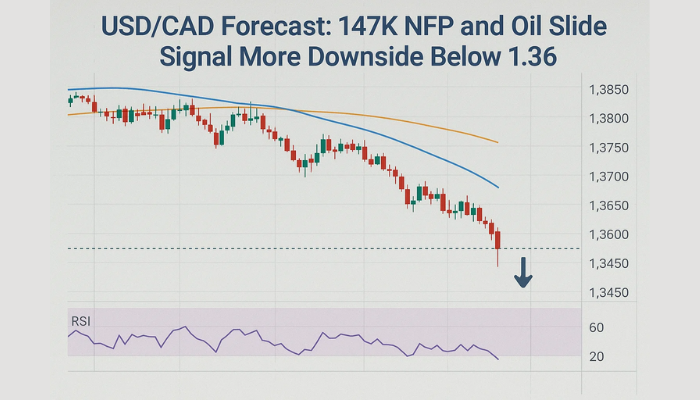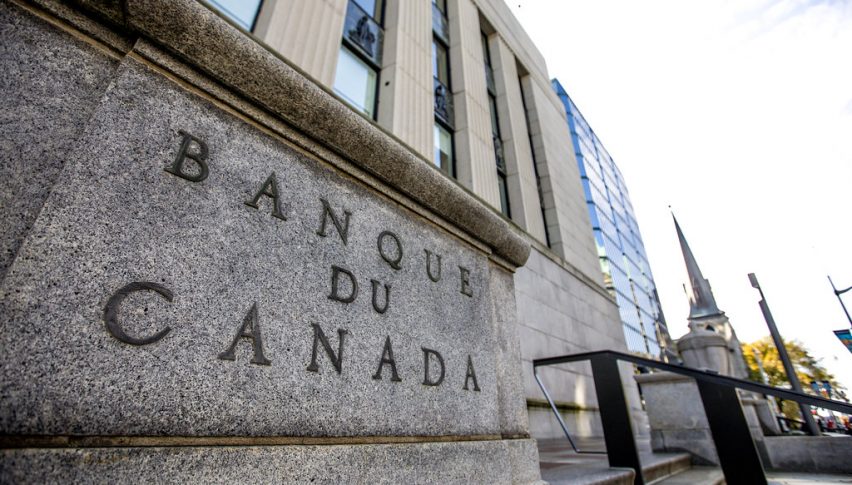Prices Forecast: Technical Analysis
For the daily forecast, USD/CAD is expected to close around 1.3610, with a potential range between 1.3580 and 1.3640. The weekly forecast suggests a closing price near 1.3625, with a range from 1.3550 to 1.3700. The RSI at 40.6489 indicates a neutral to slightly bearish sentiment, suggesting limited upward momentum. The ATR of 0.0075 points to moderate volatility, which could lead to price fluctuations within the predicted range. The ADX at 19.4794 suggests a weak trend, indicating that significant directional moves are unlikely in the short term. The MACD line remains below the signal line, reinforcing a bearish outlook. The economic calendar shows no major events directly impacting USD/CAD, allowing technical indicators to play a more significant role in price movements.
Fundamental Overview and Analysis
USD/CAD has shown a gradual decline over recent weeks, reflecting a broader trend of USD weakness against the CAD. This trend is influenced by Canada’s relatively stable economic indicators, such as the S&P Global Services PMI, which is forecasted to improve. The RSI and MACD suggest a bearish sentiment, aligning with the recent price decline. Market participants view USD/CAD as potentially undervalued, given the current economic conditions. However, risks such as global economic uncertainty and fluctuating oil prices could impact the CAD’s strength. The asset’s current valuation appears fair, with potential for growth if economic conditions remain stable. Investors should monitor economic indicators and geopolitical developments that could affect USD/CAD’s trajectory.
Outlook for USD/CAD
The future outlook for USD/CAD suggests a continuation of the current bearish trend, with potential stabilization if economic conditions improve. Historical price movements indicate a gradual decline, with moderate volatility as shown by the ATR. Key factors influencing USD/CAD include economic conditions in Canada and the US, oil prices, and global market sentiment. In the short term (1 to 6 months), USD/CAD may experience slight declines, potentially reaching 1.3550. Long-term forecasts (1 to 5 years) depend on economic growth and market dynamics, with potential for recovery if economic indicators improve. External factors such as geopolitical tensions or market crashes could significantly impact USD/CAD’s price, necessitating close monitoring by investors.
Technical Analysis
Current Price Overview: The current price of USD/CAD is 1.3609, slightly below the previous close of 1.3609. Over the last 24 hours, the price has shown limited movement, reflecting a stable yet bearish sentiment.
Support and Resistance Levels: Key support levels are at 1.3600, 1.3500, and 1.3500, while resistance levels are at 1.3600, 1.3600, and 1.3700. The pivot point is at 1.3600, with USD/CAD trading slightly below it, indicating a bearish bias.
Technical Indicators Analysis: The RSI at 40.6489 suggests a neutral to bearish trend. The ATR of 0.0075 indicates moderate volatility. The ADX at 19.4794 shows weak trend strength. The 50-day SMA and 200-day EMA do not show a crossover, suggesting a continuation of the current trend.
Market Sentiment & Outlook: Sentiment is currently bearish, as indicated by the price action below the pivot, the RSI direction, and the lack of a moving average crossover. Volatility remains moderate, suggesting limited price swings.
Forecasting Returns: $1,000 Across Market Conditions
The table below outlines potential returns on a $1,000 investment in USD/CAD under different market scenarios. In a Bullish Breakout scenario, a 5% increase could raise the investment to approximately $1,050. In a Sideways Range scenario, the investment might remain around $1,000, reflecting minimal price change. In a Bearish Dip scenario, a 5% decrease could reduce the investment to about $950. These scenarios highlight the importance of understanding market conditions and adjusting investment strategies accordingly. Investors should consider their risk tolerance and market outlook when deciding to invest in USD/CAD.
| Scenario | Price Change | Value After 1 Month |
|---|---|---|
| Bullish Breakout | +5% to ~$1,050 | ~$1,050 |
| Sideways Range | 0% to ~$1,000 | ~$1,000 |
| Bearish Dip | -5% to ~$950 | ~$950 |
FAQs
What are the predicted price forecasts for the asset?
The daily forecast for USD/CAD suggests a closing price around 1.3610, with a range between 1.3580 and 1.3640. The weekly forecast indicates a closing price near 1.3625, with a range from 1.3550 to 1.3700.
What are the key support and resistance levels for the asset?
Key support levels for USD/CAD are at 1.3600, 1.3500, and 1.3500. Resistance levels are at 1.3600, 1.3600, and 1.3700. The pivot point is at 1.3600, with the asset trading slightly below it, indicating a bearish bias.
What are the main factors influencing the asset’s price?
USD/CAD’s price is influenced by economic conditions in Canada and the US, oil prices, and global market sentiment. Technical indicators such as RSI, ATR, and ADX also play a role in determining price movements.
What is the outlook for the asset in the next 1 to 6 months?
In the short term, USD/CAD may experience slight declines, potentially reaching 1.3550. The outlook depends on economic conditions, market sentiment, and external factors such as geopolitical tensions or market crashes.
Disclaimer
In conclusion, while the analysis provides a structured outlook on the asset’s potential price movements, it is essential to remember that financial markets are inherently unpredictable. Conducting thorough research and staying informed about market trends and economic indicators is crucial for making informed investment decisions.



